Do you feel an increased pressure in your lower back or a sensation of your upper body leaning backward? Do you notice your stomach protruding or your pelvis tilting forward? If so, you may have what’s known as a “swayback” posture, also called hyperlordosis.
This condition results in a pronounced arch in the lower back and a protruding belly. It can affect health and well-being in various ways, causing back pain, impairing balance, and affecting appearance and self-esteem.
But don’t worry—there are things you can do to improve your posture and feel better! In this article, we’ll explore the causes, risks, and treatment of swayback posture and provide tips and exercises to help you align your spine and pelvis.
What is Swayback Posture?
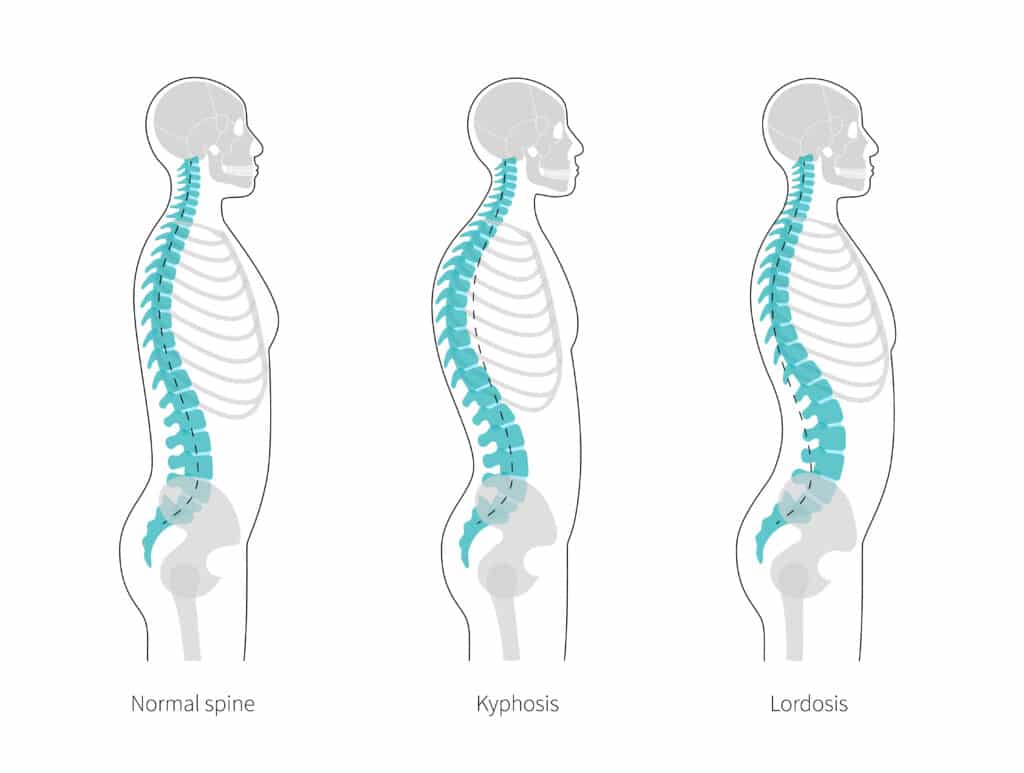
Every muscle in the body has a relationship with the others to keep the body upright and supported. The spine and pelvis work together to maintain a neutral posture, in which all the muscles in the body are correctly aligned and working together.
Postural impairments can result when these muscle relationships are asymmetric, causing spine curves that are out of balance. Swayback posture is a common pattern of posture dysfunction that differs from normal posture in the following ways:
- Your hips and pelvis are tilted forward, like a bucket spilling water on your toes. This is called anterior pelvic tilt.
- The forward shift of your pelvis causes an exaggerated curve in your lower back or lumbar spine; this is known as lumbar lordosis.
- The upper body then compensates by leaning backward, creating an exaggerated outward curve in your upper back, called kyphosis, typically accompanied by what is known as forward head posture, in which your head and neck “reach” forward to try to find equilibrium.
The misalignment of your spine and pelvis from a swayback posture can increase your risk of developing chronic pain in your back or neck, often resulting in a hunched upper body posture.
Swayback posture can be seen in people with poor posture habits—like slouching or sitting for long periods—and those with weak or imbalanced back, hips, and leg muscles.
Causes of Swayback Posture
Several factors may contribute to swayback posture, but the main cause includes some combination of the following.
Muscle imbalances and weakness
Specific muscle imbalances are known to cause more dramatic postural problems.
Suppose the hip muscles—specifically the hip flexors—and lower back muscles are tight and overactive. These tight muscles can pull the pelvis forward and cause excessive lumbar lordosis, a deeper curve in the lower back.
This hip pattern weakens the antagonist muscles—or the muscles that work on opposite side of the body—mainly the glutes and the abdominals, resulting in decreased spinal and pelvic support. Weak abdominal muscles can also cause a forward shift of the pelvis and a swayback posture.
Similarly, the muscles in the upper back are opposite the muscles of the anterior shoulders and chest. When this relationship isn’t working right, both groups of muscles can weaken and exaggerate the rounded kyphotic curve of the spine. This results in the familiar “hunchback” posture.
Poor posture habits and ergonomics
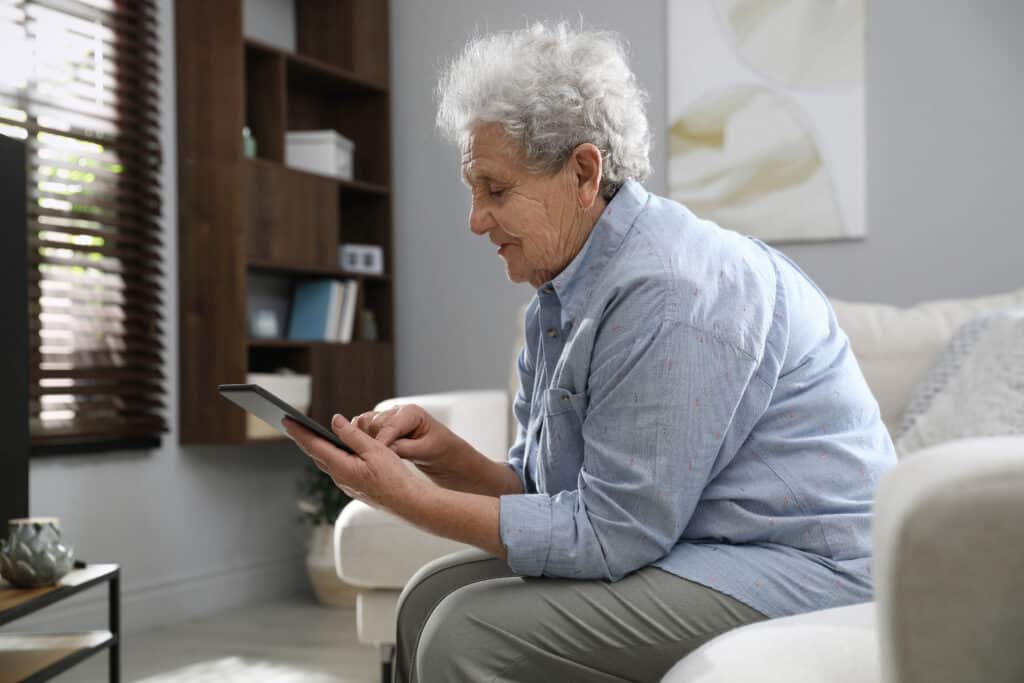
Slouching or hunching over a computer, tablet, or phone can lead to poor posture.
If you work at a desk all day, you may lean forward, and your chair or computer monitor may not be adjusted correctly to maintain good posture. This position can cause your lower back to arch excessively and your pelvis to tilt forward, leading to a swayback posture over time.
Making adjustments to the ergonomics of your work area may help to counter some of these negative effects.
Additionally, frequently carrying heavy bags or wearing high heels alters your center of gravity, putting extra stress on your lower back and pelvis. These postural patterns can exacerbate any existing muscle imbalances or postural issues.
Aging & Degenerative Changes
Aging and degenerative changes can cause spinal changes, like decreased flexibility, increased pressure on the vertebral joints, and alterations in the spine’s natural curvature.
Although these changes are a natural part of aging, staying active, maintaining good posture habits, and seeking appropriate medical care can help reduce the risk of developing a swayback posture.
Overweight & Obesity
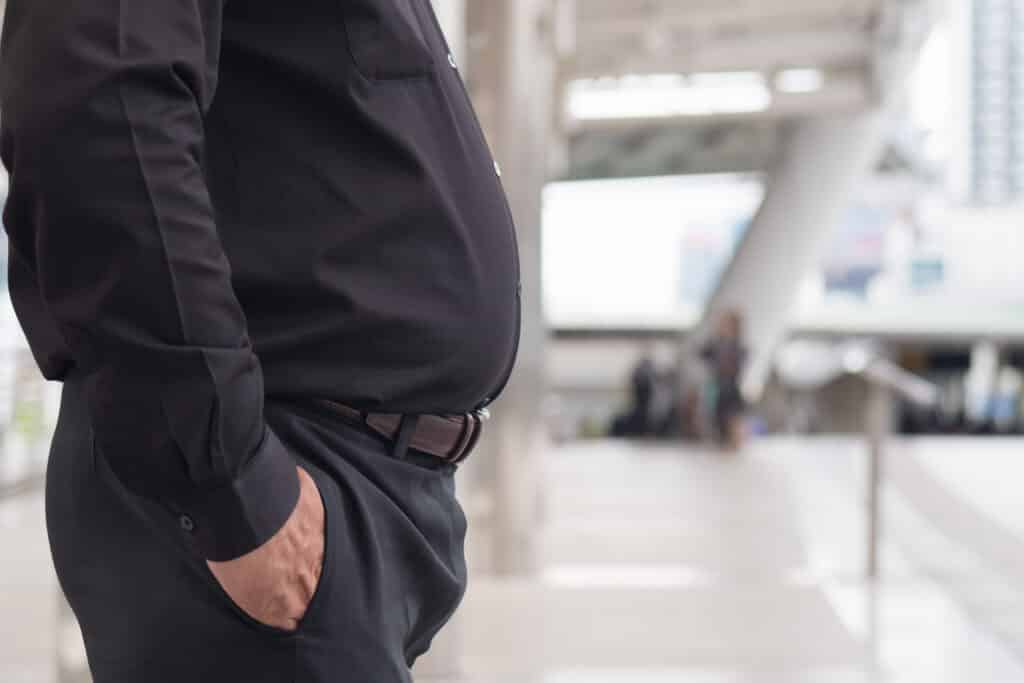
Excess weight, especially a “beer belly,” can contribute to swayback posture by altering the center of gravity. The weight imbalance on the front of the body puts more pressure on the lower back, much like in pregnant women, as the baby grows and becomes heavier.
Obesity can also contribute to poor core muscle strength and abdominal muscle separation, similar to the experience of pregnant women.
Risks of Swayback Posture
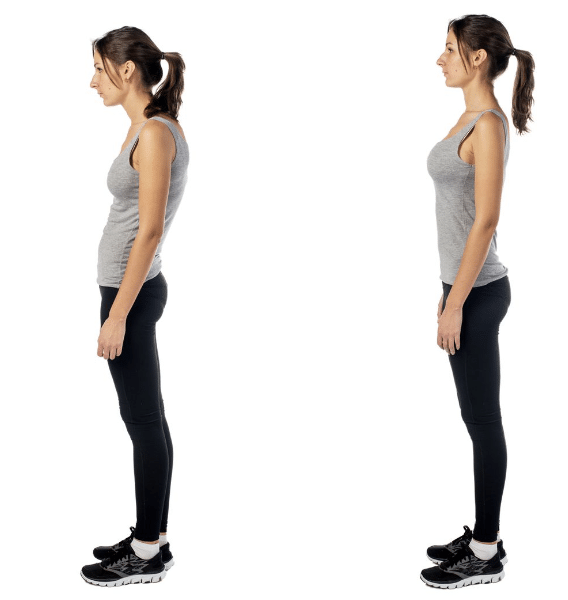
Swayback posture can have several negative consequences for your health and well-being. Here are some of the primary risks associated with these posture patterns.
Back pain and stiffness
Decreased activity levels result in sedentary behavior and prolonged sitting, worsening pain symptoms, stiffness, and inflexibility. On average, people with higher levels of disability due to low back pain were found to have lower levels of overall physical activity.5
Other studies indicate that hyperlordosis is associated with degeneration in the facet joints of the lower lumbar spine, leading to chronic back pain.3,4
Reduced mobility and increased injury and fall risk
The excessive curvature of the spine can limit your range of motion and affect your ability to perform daily activities.
For example, you may have difficulty bending forward or twisting your torso. Decreased mobility can make daily tasks more difficult or even dangerous, often provoking further injuries.
Weakness, a sedentary lifestyle, and poor postural control significantly worsen a person’s fall risk. This is particularly important for seniors at much higher risk of falling and its consequences. [3]
By shifting your center of gravity backward, a swayback posture may result in impaired balance and difficulty maintaining equilibrium. Often, my patients report a sensation as if they are constantly “falling backward,” and indeed, this position can cause an elevated fall risk.
Impaired breathing and digestion
The compression of the diaphragm in a swayback posture restricts its movement, leading to shallow breathing and reduced lung capacity.
Additionally, the misalignment and compression of abdominal organs can disrupt digestion, resulting in decreased gut motility, inefficient nutrient absorption, and increased risk of abdominal discomfort.
Affects appearance and self-esteem
A swayback posture can also cause a visibly altered appearance. This can lead to self-consciousness and a negative body image, impacting self-esteem and confidence.
Exercises & Treatment for Swayback Posture
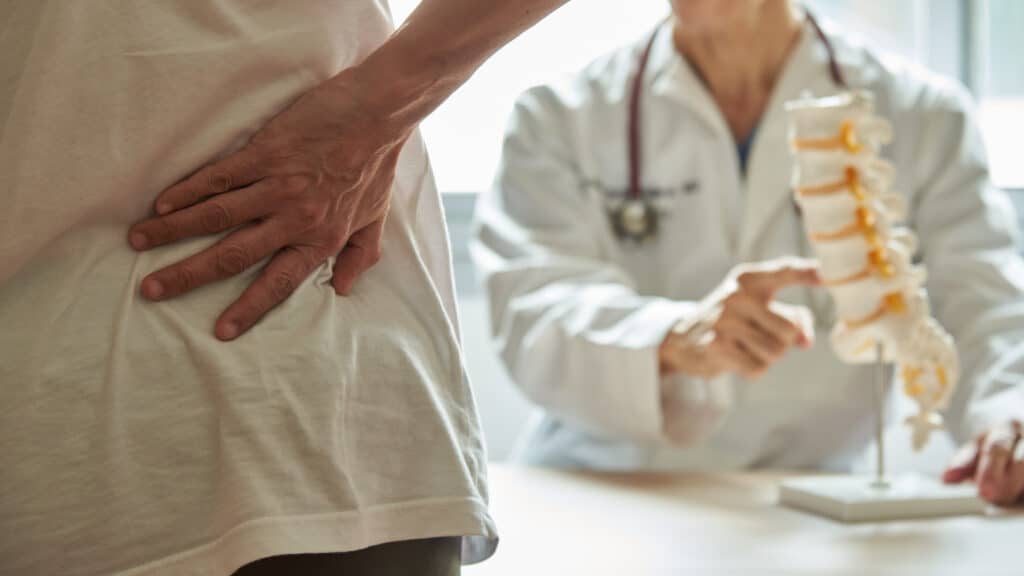
If you have a pronounced swayback posture, it’s a good idea to seek help from a physical therapist or a doctor who can provide a proper diagnosis and treatment plan. A comprehensive treatment regimen will likely include the following:
- Improving muscle coordination
- Strengthening the muscles that support the spine and pelvis
- Improving postural habits
- Ergonomic adjustments to home or workspaces
Additional recommendations I provide to my patients include modifying or avoiding activities that aggravate this lumbar curve. I may even recommend using appropriate braces, supports, or devices.
Still, it should be noted that any braces or external supports should reinforce other exercises or behavioral changes, not provide a substitution.
Exercise may help improve lumbar lordosis angle and reduce pain and functional disability in older adults. Various movements, stretches, and techniques can help correct swayback posture. [5]
Let’s review some exercises I often recommend to my patients with hyperlordosis.
Pelvic tilts and glute bridges
These exercises can strengthen the glutes and hamstrings and help realign the pelvis. Both exercises are performed lying on your back with your knees bent and feet flat on the floor. However, as in the video below, you can also do pelvic tilts while standing.
Standing Pelvis Tilts
To perform a posterior pelvic tilt:
- Engage your abdominal muscles and gently tilt your pelvis upward by pressing your lower back into the floor while keeping your hips and legs relaxed.
- Hold the position for a few seconds, then release and return to the starting position.
Glute Bridges
To perform a glute bridge:
- Place your arms by your sides with palms facing down. Engage your core muscles to stabilize your spine and pelvis.
- Push your heels into the ground and lift your hips towards the ceiling, squeezing your glutes at the top of the movement.
- Your body should form a straight line from your shoulders to your knees. Hold for a few seconds before slowly lowering your hips to the starting position.
If you want to try the pelvic tilt while lying down, simply come to the top of the bridge motion and actively tilt your pelvis towards your chin, just like the standing version.
Abdominal bracing and planks
Core strengthening is critical to improving trunk and spinal stability and improving posture.
Abdominal bracing can start lying on your back with your knees bent and feet flat on the floor.
- Place your hands on your belly and take a deep breath in, allowing your belly to expand.
- As you exhale, draw your belly button towards your spine and contract your abs.
- Hold this position for a few seconds, then release and repeat for several repetitions.
- Make sure to breathe normally while performing the exercise, and avoid holding your breath.
Planks
A plank is a core exercise where you start in a push-up position, with your hands directly under your shoulders and your body straight from head to heels.
- Engage your core muscles by drawing your belly button toward your spine, and hold the position for 30-60 seconds.
- Keep your hips level and avoid letting your lower back sag or your hips pike up.
Lumbar stabilization
Lumbar stabilization exercises aim to improve the strength and endurance of the muscles that support the lower back. They may help improve the degree of pelvic tilt and reduce the pain scale in individuals with chronic low back pain.4
- Lie down on your stomach with your legs out straight.
- Tighten your abdominal muscles, then lift one leg off the ground and hold it for a few seconds before returning it to the ground.
- Repeat with the other leg. Alternatively, you can lift both legs at the same time.
Hip flexor and hamstring stretches
Tight hamstrings and hip flexors can worsen swayback posture. Stretches for these muscles release tension in the front of the hips and thighs and reduce lower back pain.
Hip Flexor Stretch
To perform a hip flexor stretch:
- Start in a lunge position with your back knee on the ground and your front foot flat on the floor.
- Press your hips forward until you feel a stretch in the front of your hip. Hold for thirty seconds or more.
Hamstring Stretch
To stretch your hamstrings:
- Stand next to a chair or another stable surface for support.
- Place the heel of one foot on a raised surface like a stair or an ottoman.
- Wich a flat back, lean forward until you feel a stretch in the back of your hip and thigh,
- Hold each stretch for 20-30 seconds and repeat on both legs.
Spinal decompression and traction
Traction can help elongate the spine and alleviate compression. It typically involves a specially designed table or device that applies gentle pulling forces to the spine.
This spinal stretch creates space between the vertebrae, alleviating pressure on nerves and discs. The force and duration of the traction can vary depending on the individual’s condition and the type of equipment used.
Consult a healthcare professional before spinal decompression or traction, as it may not suit everyone.
Postural awareness and correction exercises
These corrective exercises aim to improve muscle imbalances that contribute to poor posture.
Some examples of these exercises include shoulder blade retractions, chin tucks, and scapular wall slides.
Shoulder Blade Retractions
Shoulder blade retractions involve actively squeezing your shoulder blades together. This movement helps to correct postural issues caused by rounded shoulders.
Chin Tucks
Similarly to shoulder blade retractions, chin tucks can help correct forward head position due to poor posture.
With a tall posture, simply draw your chin straight back as if you’re trying to touch the back of your head to the wall behind you.
Scapular Wall Slides
Scapular Wall Slides involve standing with your back against a wall, with your arms at your sides and elbows bent. Slowly slide your arms up the wall while keeping your shoulders relaxed, then lower them back down.
The most important component of this exercise involves keeping your core firmly engaged. Throughout the wall slide, engage the muscles around your midsection to keep your back flat and your belly tight.
Perform these exercises daily to improve posture and reduce the associated pain and discomfort risk.
Key Takeaways
- Swayback posture, a common postural dysfunction, results in an arch in the lower back and a protruding belly, often causing back pain, impaired balance, and self-esteem issues.
- This condition develops due to muscle imbalances, poor postural habits, aging, degenerative changes, or obesity.
- Risks associated with swayback posture include chronic back pain, reduced mobility, increased fall risk, impaired breathing and digestion, and a negative impact on appearance and self-esteem.
- Treatment typically involves improving muscle coordination, strengthening supporting muscles, enhancing postural habits, and making ergonomic adjustments. Braces or supports may supplement these strategies but should not replace them.
- Seek professional guidance from physical therapists or doctors for diagnosis and treatment planning.
FAQs
What is swayback posture?
Swayback posture, also known as hyperlordosis, is a condition characterized by an exaggerated curve in the lower back, a forward tilt of the pelvis, and a protruding belly. It often includes an upper body leaning backward, which can affect balance, appearance, and self-esteem.
What causes swayback posture?
Several factors, including muscle imbalances, poor posture habits, aging, degenerative changes, and obesity can cause swayback posture. Tight or overactive muscles, such as the hip flexors and lower back muscles, combined with weak abdominal and gluteal muscles, can contribute to this condition.
What are the risks associated with swayback posture?
Swayback posture can lead to chronic back pain, stiffness, reduced mobility, increased risk of injury and falls, impaired breathing and digestion, and a negative impact on appearance and self-esteem. These issues arise from the misalignment of the spine and pelvis, which affects overall body mechanics.
How can I correct swayback posture?
Correcting swayback posture involves improving muscle coordination, strengthening the muscles that support the spine and pelvis, and enhancing postural habits. Exercises like pelvic tilts, glute bridges, and core strengthening activities like planks can help realign the body. Additionally, making ergonomic adjustments to workspaces and avoiding activities that exacerbate the condition is important.
Can wearing braces or supports help with swayback posture?
Braces and supports can provide temporary relief and assist in maintaining proper posture, but they should not replace exercises or behavioral changes. These devices are best used to supplement a comprehensive treatment plan that includes physical therapy and exercises designed to strengthen supporting muscles and improve posture.
When should I seek professional help for swayback posture?
If you experience chronic back pain, difficulty performing daily activities, or other symptoms associated with swayback posture, it’s advisable to seek professional guidance from a physical therapist or doctor. A healthcare professional can properly diagnose the condition, create a personalized treatment plan, and recommend exercises and ergonomic changes to improve posture and alleviate discomfort.
References
- Franklin M.E., Conner-Kerr T., & Bernhardt J. (2015). Diastasis recti abdominis: A survey of women’s health specialists for current physical therapy clinical practice for postpartum women. Journal of Women’s Health Physical Therapy , 39(3), 115-126.
- Kado D.M., Huang M.H., Karlamangla A.S., Barrett-Connor E., & Greendale G.A. (2009). Hyperkyphotic posture predicts mortality in older community-dwelling men and women: A prospective study . Journal of the American Geriatrics Society , 57(10), 1817-1823.
- Kendall F.P., McCreary E.K., Provance P.G., Rodgers M.M., & Romani W.A. (2005). Muscles: Testing and function , with posture and pain (5th ed.). Lippincott Williams & Wilkins.
- Lee J.H., Hoshino Y., Nakamura K., Kariya Y., Saita K., & Ito K. (2017). Trunk muscle weakness as a risk factor for low back pain: A 5-year prospective study . Spine , 22(3), 308-312.
- Lee S.H., Kim J.Y., Yoon B.W., Lee S.J., & Park G.T. (2017). The effect of lumbar stabilization exercise on the pulmonary function of stroke patients . Journal of Physical Therapy Science , 29(2), 256-259.






